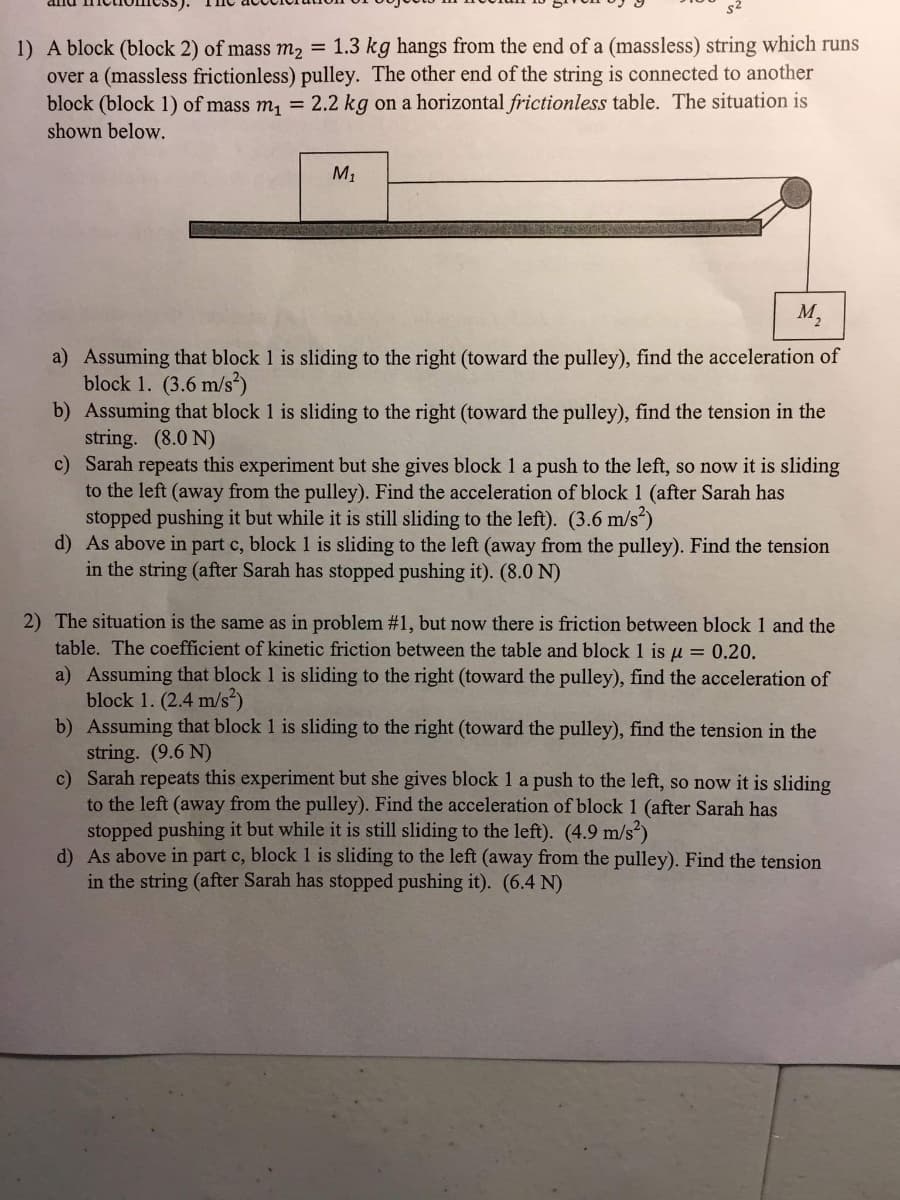D A block (block 2) of mass m2 = 1.3 kg hangs from the end of a (massless) string which runs over a (massless frictionless) pulley. The other end of the string is connected to another block (block 1) of mass m, = 2.2 kg on a horizontal frictionless table. The situation is shown below. M1 M2 a) Assuming that block 1 is sliding to the right (toward the pulley), find the acceleration of block 1. (3.6 m/s) b) Assuming that block 1 is sliding to the right (toward the pulley), find the tension in the string. (8.0 N) c) Sarah repeats this experiment but she gives block 1 a push to the left, so now it is sliding to the left (away from the pulley). Find the acceleration of block 1 (after Sarah has stopped pushing it but while it is still sliding to the left). (3.6 m/s) d) As above in part c, block 1 is sliding to the left (away from the pulley). Find the tension in the string (after Sarah has stopped pushing it). (8.0 N)
D A block (block 2) of mass m2 = 1.3 kg hangs from the end of a (massless) string which runs over a (massless frictionless) pulley. The other end of the string is connected to another block (block 1) of mass m, = 2.2 kg on a horizontal frictionless table. The situation is shown below. M1 M2 a) Assuming that block 1 is sliding to the right (toward the pulley), find the acceleration of block 1. (3.6 m/s) b) Assuming that block 1 is sliding to the right (toward the pulley), find the tension in the string. (8.0 N) c) Sarah repeats this experiment but she gives block 1 a push to the left, so now it is sliding to the left (away from the pulley). Find the acceleration of block 1 (after Sarah has stopped pushing it but while it is still sliding to the left). (3.6 m/s) d) As above in part c, block 1 is sliding to the left (away from the pulley). Find the tension in the string (after Sarah has stopped pushing it). (8.0 N)
Principles of Physics: A Calculus-Based Text
5th Edition
ISBN:9781133104261
Author:Raymond A. Serway, John W. Jewett
Publisher:Raymond A. Serway, John W. Jewett
Chapter5: More Applications Of Newton’s Laws
Section: Chapter Questions
Problem 46P: An aluminum block of mass m1 = 2.00 kg and a copper block of mass m2 = 6.00 kg are connected by a...
Related questions
Question
Solve the problem in Newton's 2nd Law of Motion. Please answer 1 a, b, c, and d and 2 a, b, c , and d.

Transcribed Image Text:1) A block (block 2) of mass m2 = 1.3 kg hangs from the end of a (massless) string which runs
over a (massless frictionless) pulley. The other end of the string is connected to another
block (block 1) of mass m, = 2.2 kg on a horizontal frictionless table. The situation is
shown below.
M1
M,
a) Assuming that block 1 is sliding to the right (toward the pulley), find the acceleration of
block 1. (3.6 m/s*)
b) Assuming that block 1 is sliding to the right (toward the pulley), find the tension in the
string. (8.0 N)
c) Sarah repeats this experiment but she gives block 1 a push to the left, so now it is sliding
to the left (away from the pulley). Find the acceleration of block 1 (after Sarah has
stopped pushing it but while it is still sliding to the left). (3.6 m/s)
d) As above in part c, block 1 is sliding to the left (away from the pulley). Find the tension
in the string (after Sarah has stopped pushing it). (8.0 N)
2) The situation is the same as in problem #1, but now there is friction between block 1 and the
table. The coefficient of kinetic friction between the table and block 1 is u = 0.20.
a) Assuming that block 1 is sliding to the right (toward the pulley), find the acceleration of
block 1. (2.4 m/s?)
b) Assuming that block 1 is sliding to the right (toward the pulley), find the tension in the
string. (9.6 N)
c) Sarah repeats this experiment but she gives block 1 a push to the left, so now it is sliding
to the left (away from the pulley). Find the acceleration of block 1 (after Sarah has
stopped pushing it but while it is still sliding to the left). (4.9 m/s?)
d) As above in part c, block 1 is sliding to the left (away from the pulley). Find the tension
in the string (after Sarah has stopped pushing it). (6.4 N)
Expert Solution
This question has been solved!
Explore an expertly crafted, step-by-step solution for a thorough understanding of key concepts.
This is a popular solution!
Trending now
This is a popular solution!
Step by step
Solved in 2 steps with 1 images

Knowledge Booster
Learn more about
Need a deep-dive on the concept behind this application? Look no further. Learn more about this topic, physics and related others by exploring similar questions and additional content below.Recommended textbooks for you

Principles of Physics: A Calculus-Based Text
Physics
ISBN:
9781133104261
Author:
Raymond A. Serway, John W. Jewett
Publisher:
Cengage Learning

College Physics
Physics
ISBN:
9781305952300
Author:
Raymond A. Serway, Chris Vuille
Publisher:
Cengage Learning

College Physics
Physics
ISBN:
9781285737027
Author:
Raymond A. Serway, Chris Vuille
Publisher:
Cengage Learning

Principles of Physics: A Calculus-Based Text
Physics
ISBN:
9781133104261
Author:
Raymond A. Serway, John W. Jewett
Publisher:
Cengage Learning

College Physics
Physics
ISBN:
9781305952300
Author:
Raymond A. Serway, Chris Vuille
Publisher:
Cengage Learning

College Physics
Physics
ISBN:
9781285737027
Author:
Raymond A. Serway, Chris Vuille
Publisher:
Cengage Learning

Classical Dynamics of Particles and Systems
Physics
ISBN:
9780534408961
Author:
Stephen T. Thornton, Jerry B. Marion
Publisher:
Cengage Learning